Hi,
This is the second post on the Key-signature series. The first one is here
In this post I will list the key signatures corresponding to major keys using sharps. That is :
- G major
- D major
- A major
- E major
- B major
- F♯ major
- C♯ major
And then discuss the technique to memorise those key signatures
You can check this post and this other post if you want to be comfortable with major scales.
List of the major key signature using ♯
The key of G major
Here is the key signature for G major :

In the following score, I wrote a G major scale with no Key-signature in the first 2 bars. Then I wrote a new key signature (G major : 1 ♯) and again, the G major scale. As you can see, once the Key-signature is written, there is no need to write the ♯ again.
The key of D major
Here is the key signature for D major :
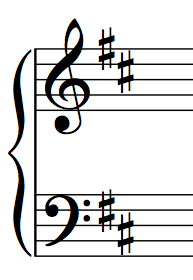
In the following score, I wrote a D major scale with no Key-signature in the first 2 bars. Then I wrote a new key signature (D major : 2 ♯) and again, the D major scale. As you can see, once the Key-signature is written, there is no need to write the ♯ again.
The key of A major
Here is the key signature for A major :

In the following score, I wrote a *A major scale with no Key-signature in the first 2 bars. Then I wrote a new key signature (A major : 3 ♯) and again, the A major scale. As you can see, once the Key-signature is written, there is no need to write the ♯ again.
The key of E major
Here is the key signature for E major :
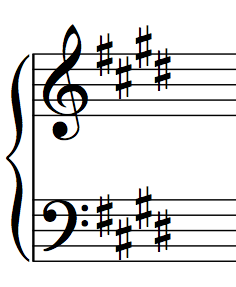
In the following score, I wrote a E major scale with no Key-signature in the first 2 bars. Then I wrote a new key signature (E major : 4 ♯) and again, the E major scale. As you can see, once the Key-signature is written, there is no need to write the ♯ again.
The key of B major
Here is the key signature for B major :
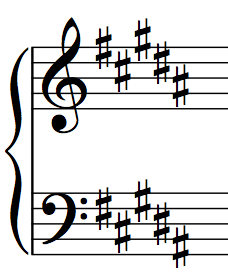
In the following score, I wrote a B major scale with no Key-signature in the first 2 bars. Then I wrote a new key signature (B major : 5 ♯) and again, the B major scale. As you can see, once the Key-signature is written, there is no need to write the ♯ again.
The key of F♯ major
Here is the key signature for F♯ major :
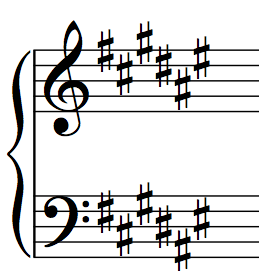
In the following score, I wrote a F♯ major scale with no Key-signature in the first 2 bars. Then I wrote a new key signature (F♯ major : 6 ♯) and again, the F♯ major scale. As you can see, once the Key-signature is written, there is no need to write the ♯ again.
The key of C♯ major
Here is the key signature for C♯ major :
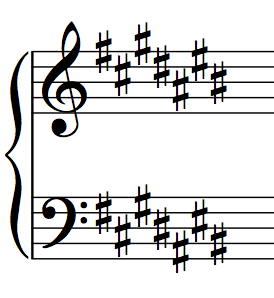
In the following score, I wrote a C♯ major scale with no Key-signature in the first 2 bars. Then I wrote a new key signature (C♯ major : 7 ♯) and again, the C♯ major scale. As you can see, once the Key-signature is written, there is no need to write the ♯ again.
How to memorise this list ?
If you know the key, and want to write the key signature :
The first thing to know, is your major scales. (If you know the A major scale, you know that it's spelled a-b-c♯-d-e-f♯-g♯-a. There is 3 ♯, end of the story.)
The second thing to know, is the order of the sharps. It starts with F♯, and then goes up a perfect fifth, so you get to C♯, and then up a perfect fifth, so you get to G♯, and so on. The list of sharps is : F♯-C♯-G♯-D♯-A♯-E♯-B♯
You can now write the sharps (in A major, it would be 3 ♯) using the right order.
If you know the key signature, and want to know the key :
Take the last sharp of the key signature, add a semitone : here is the major key corresponding to the key signature.
For example, if you have a key signature with 4 sharps (F♯-C♯-G♯-D♯). Add a semitone to the last sharp : D♯ plus a semitone is E.
The key is E major. (we will see later that the same key signature can be used to a minor key)
Try to read this post again, and see if you got it : can you connect the keys to their key signatures ?
You can practice using this excellent game too.
Have a nice day
Sebastien
Check out the other articles in this series:
-
Key signatures 2/4 : major keys - sharps
